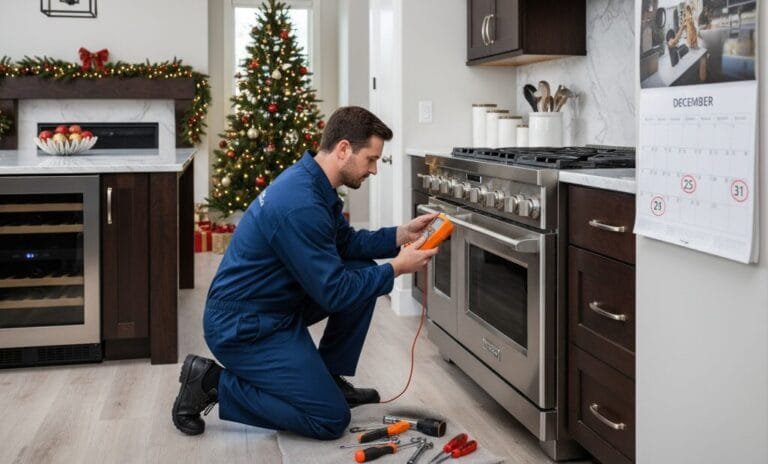When your favorite casserole emerges beautifully browned on one side yet gooey and undercooked on the other, the culprit is often not your recipe but a hardware failure: the oven’s bake element. As the primary source of radiant heat in electric ovens, the bake element ensures that temperatures throughout the cavity stay consistent. Over time, repeated heating cycles, food spills, and gradual insulation breakdown can cause the element to fail—leading to hot spots, cold spots, and frustratingly uneven cooking.
At Romano’s Appliance Repair, we have over a decade of experience restoring ovens to their factory-spec performance. Our certified technicians follow rigorous diagnostic protocols to pinpoint a failing bake element and replace it safely, quickly, and correctly the first time. Below, we explain why the bake element is so critical, how to recognize its failure, and why professional service should be your first call.

Why the Bake Element Matters
In an electric oven, two coils work in tandem: the upper broil element for direct, high-heat cooking and the lower bake element for steady, radiant warmth. When you set the oven to 350°F, the internal thermostat cycles power on and off to the bake element, maintaining the set temperature. A healthy element heats evenly and responds precisely to thermostat controls. However, as the element ages, its internal wiring and protective sheath can degrade. Tiny fractures develop, insulation breaks down, and the coil’s resistance changes—resulting in uneven heat distribution and temperature fluctuations that no amount of rack repositioning can correct.
Spotting a Failing Bake Element
Homeowners often notice the problem in one of three ways:
- Uneven Browning: On a single baking tray, cookies at the back may turn dark brown while those at the front remain pale.
- Longer Preheat Times: Your oven takes significantly longer than usual to reach the set temperature—or fails to get there at all.
- Visible Damage: When you remove the bottom rack for cleaning, you see dark spots, blisters, or small cracks along the element’s surface.
These symptoms can mimic other issues—such as a faulty thermostat, damaged wiring, or control board malfunctions—so accurate testing is key before purchasing replacement parts.
The Importance of Professional Diagnosis
DIY fixes without proper testing often lead to wasted time and expense. Romano’s Appliance Repair technicians begin every service call by cutting power at the breaker and safely removing the bake element. Using a calibrated multimeter, we measure the element’s resistance, comparing it against manufacturer specifications (typically 15–40 ohms). An “open” reading confirms internal breakage; a reading far outside the acceptable range signals insulation loss. Only once we verify that the element itself is defective—not the thermostat or wiring—do we proceed with a replacement. This methodical approach ensures you pay only for the parts and labor you truly need.
What to Expect During Replacement
When you schedule service with Romano’s, you benefit from:
- Certified Expertise: All our technicians are factory-trained on leading brands—Whirlpool, GE, Samsung, Bosch, and more—and follow UL/ETL electrical safety standards.
- Genuine OEM Parts: We stock original bake elements or premium aftermarket equivalents guaranteed to match your oven’s performance.
- Precision Installation: We mount the new element using manufacturer-specified torque settings, preventing air gaps and electrical arcing.
- Comprehensive Testing: After installation, we run a timed bake cycle and use an infrared thermometer to verify that your oven reaches and holds the correct temperature across its full breadth.
Most replacements, including diagnostics and calibration, take just 1–2 hours—often completed on the same day you call.
Extending Your Oven’s Lifespan
Even a high-quality element will wear out eventually, but simple care can delay its retirement:
- Keep it Clean: Wipe up spills promptly with mild detergent; avoid abrasive scrubbers on the coil.
- Use Proper Cookware: Elevate pans on racks—never rest them directly on the oven floor.
- Schedule Annual Checkups: A yearly professional inspection catches early signs of insulation breakdown or wiring fatigue.
Restore Even Baking Today
Uneven heat not only ruins your recipes but can also mask other emerging problems. Instead of guessing at the cause, call Romano’s Appliance Repair—San Diego’s trusted experts in oven diagnostics and repair. With our blend of certified skill, genuine parts, and transparent pricing, we ensure your oven bakes evenly so you can focus on creating delicious meals.
Contact Romano’s Appliance Repair:
- Phone: (561) 352-8870
- Email: romanosappliance@gmail.com
- Website: www.romanosappliancerepair.com
Let us bring your oven back to top performance—because every recipe deserves perfect heat.





